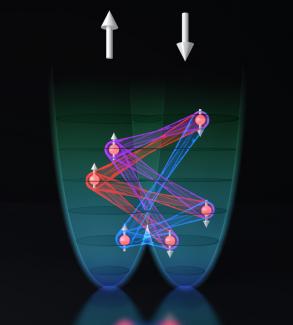For a long time, there’s been a mystery concerning how tiny interactions between individual atoms could lead to really big changes in a whole cloud of independent-minded particles. The reason this behavior is mysterious is that the atoms interact weakly, and only when they are very close to each other. Yet, the atoms clear across the cloud seem to know when it’s time to participate in some big-deal quantum behavior such as simultaneously all changing the direction of their spins.
Now graduate student Andrew Koller and his colleagues in the Rey group have solved the mystery! The atoms coordinate their behavior over long distances through energy space! No matter what energy state an atom is in, eventually it will slosh into another atom, sharing information about its spin state. If one atom passes close to another atom, it may rotate its spin a little and keep going. Then it passes the next atom, and rotates its spin a little and keeps going. Eventually the atoms can talk to all the other atoms in the cloud if the interactions between the atoms are weak.
However, if the interactions are strong, an atom running into another atom will not be able to keep going. Both atoms will bounce off each other like billiard balls. When this happens, interatomic communication spreads one collision at a time, rather than all at once over long distances.
“Think about how you can spread information,” explained Koller. “One way is word of mouth: each individual tells something to one other individual. The information spreads, but at a steady rate. And what’s said might change a little each time. A second way to pass along information is to post something online and watch it go viral. People share it with their friends, who share it with their friends, and pretty soon everyone knows the same information.”
Word of mouth communication is like strong interactions between atoms. In this case, the information propagates steadily from one atom to the next. In contrast, spin correlations in a weakly interacting cloud of atoms emerge from individual weak interactions that somehow go viral.
Atoms can communicate both ways, but, unlike people, they don’t spread misinformation. Atoms can only tell other atoms whether to be spin up or spin down
The researchers responsible for this idea about interatomic communication include Koller, former senior research associate Michael Wall, Fellow Ana Maria Rey, and Josh Mundinger of Swarthmore College.––Julie Phillips




